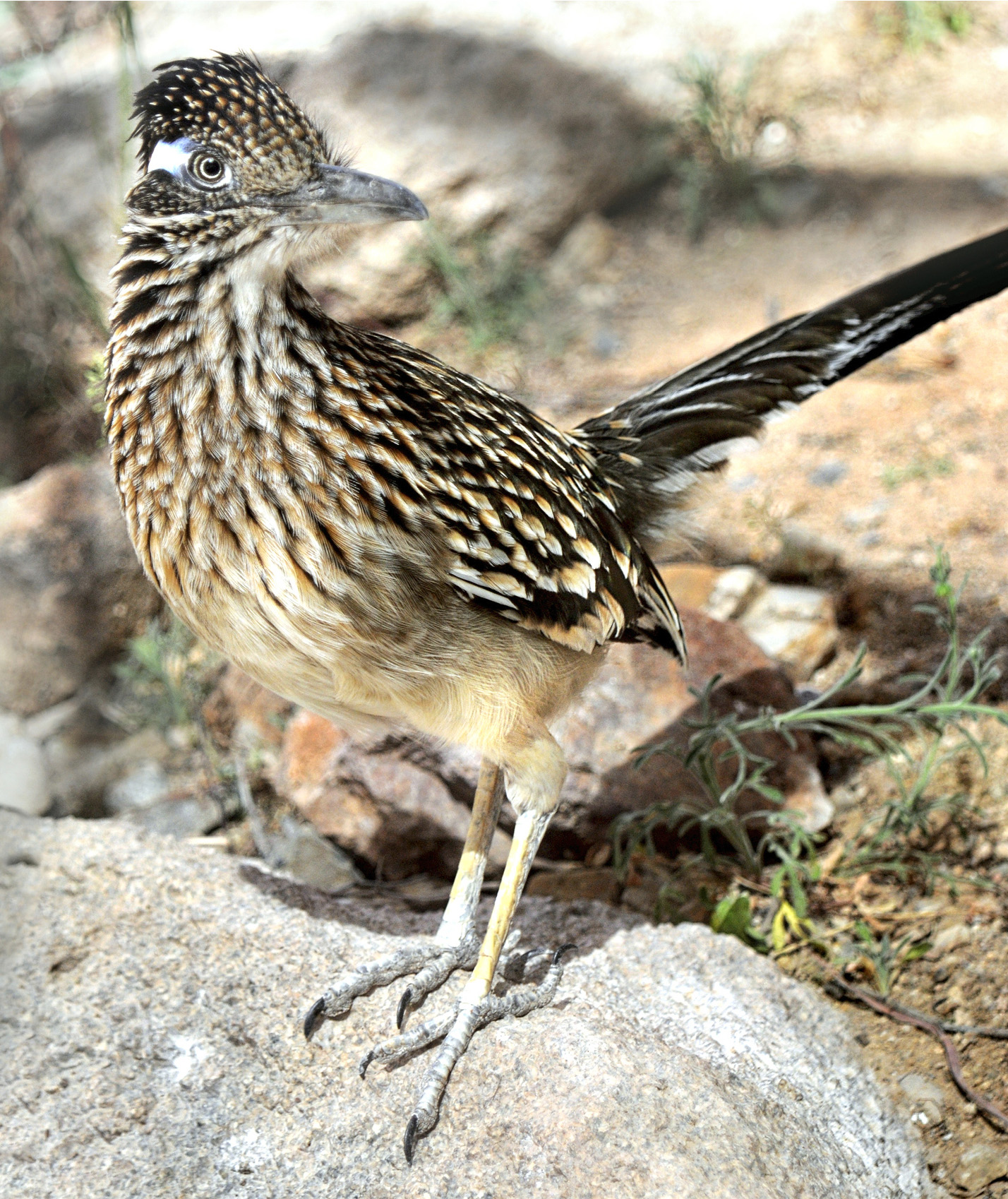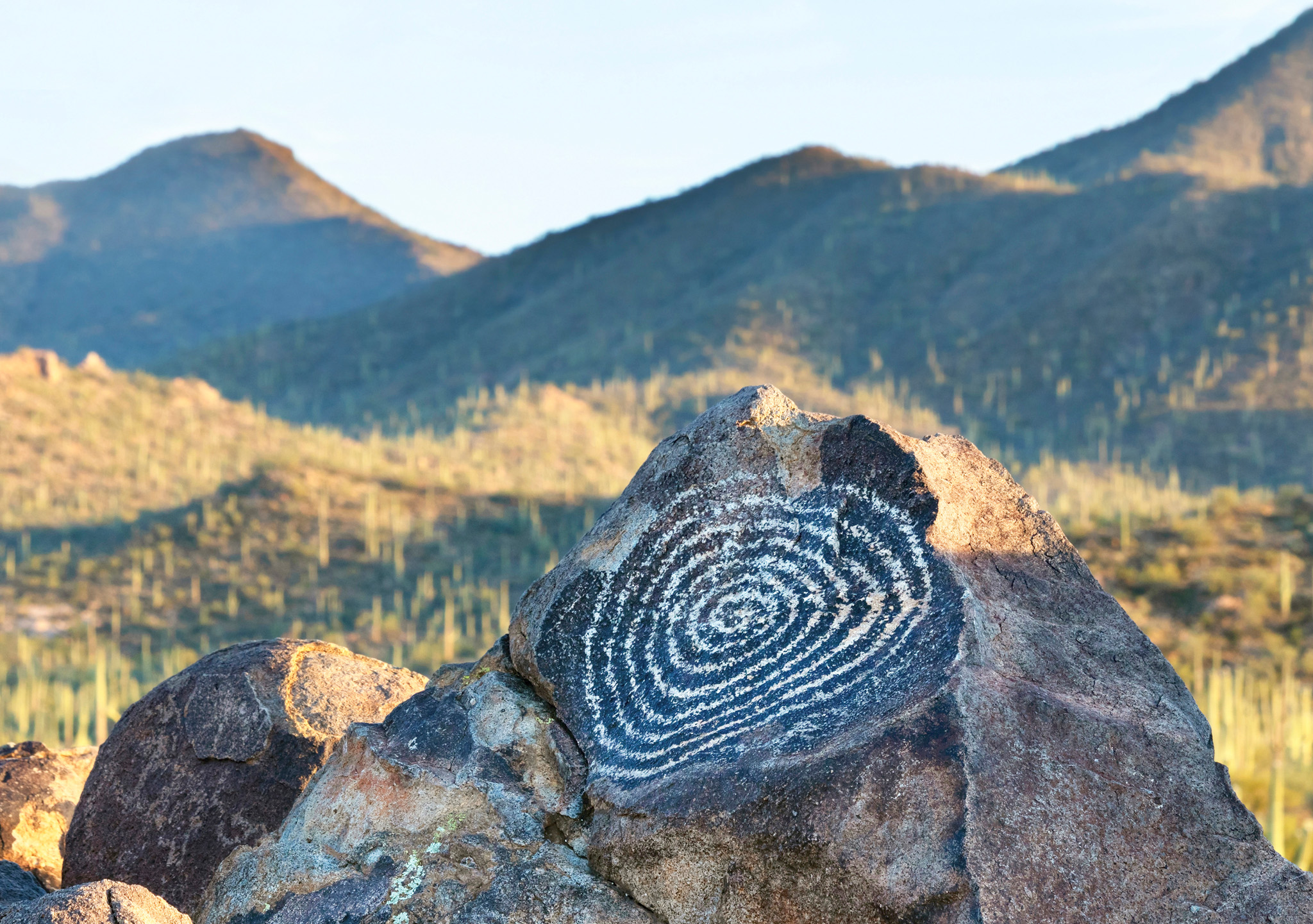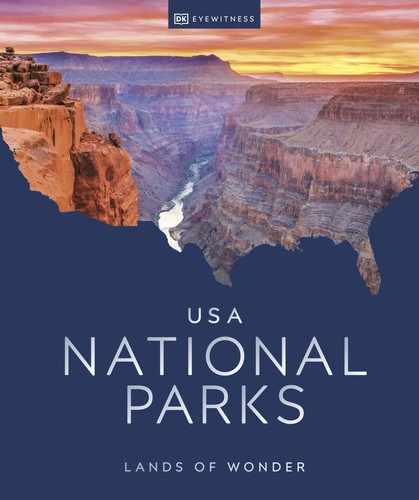
Arizona
SAGUARO
ESTABLISHED 1994
The giant, multi-armed saguaro cactus is a much-loved symbol of the Old West, and these spiked giants show off in all their stern glory in the sprawling national park.
The silhouette of a towering saguaro, stretching its enormous arms skyward against a blazing pink-and-orange sunset is as iconic a Southwestern image as it gets. Surprisingly though, this regal cactus, the largest in the US, grows only in the Sonoran Desert of southern Arizona and northern Mexico. Saguaro National Park, comprising two areas on the eastern and western edges of Tucson, was established to protect these one-of-a-kind plants.
The fascinating saguaro grows to 60 ft (18 m) tall. Beneath its thick, spiny skin is a reservoir of water that it drinks in during the rainy season. When the larder is full, a mature cactus can weigh up to 4,800 pounds (2,175 kg). These cacti are incredibly slow growers, with their first fledgling arms appearing when the plant is 75 to 100 years old. Under the right conditions, the mighty saguaro can live for two centuries.
Forest of cacti
The park preserves some of the world’s last saguaro “forests,” which once covered this desert. Encroaching human development has, sadly, hit their numbers hard.
The park’s scenic roadways and the many hiking, biking, and horseback trails wending through the desert scape make it easy for visitors to explore this exceptional biome and discover the curious plants and elusive animals that thrive in this harsh but intriguing desert wonderland.
![]()
In April, temperatures are cooler, and colorful cactus flowers bloom throughout the park.
Sonoran plant life is fascinating up close. As you walk the trails, you’ll encounter a mind-boggling array of cacti, including fuzzy teddy-bear cholla, with their deceptively soft-looking branches; short, spiny hedgehogs and tiny round pincushion cacti; and dense clumps of prickly pear. All bloom together in a magnificent display of bright pink, yellow, red, and purple flowers in the spring and early summer. There are shady pockets of mesquite and green-barked palo verde trees, and, of course, saguaros everywhere, as individual as humans in shape and character.

The stately saguaro stands tall against a nearly cloudless blue sky
Heat-loving animals
This hot, parched landscape supports a surprising variety of wildlife. Many animals are elusive or nocturnal, but on quiet trails you may spot coyotes, javelina, mule deer, or jackrabbits. Watch for the sharp-beaked, greater roadrunners and plumed, black-faced Gambel’s quail scurrying through the underbrush. Tiny hummingbirds hover over cactus flowers, and red-tailed hawks and huge ravens soar above. Listen for the scolding of the cactus wrens and the tapping of Gila woodpeckers, who carve out nests in the saguaros. And keep an eye out everywhere for the creature that commands the greatest respect: the rattlesnake.

An alert greater roadrunner looks poised to take off at any minute
Three Hikes

Easy ▷ Wild Dog Trail, 1.8 miles (3 km) round trip. This peaceful trail in Saguaro West leads through cacti and wildflowers to a low ridge with splendid views over a saguaro-filled valley.
Moderate Cactus Forest Trail, 10 miles (16 km) round trip. The mostly flat route in Saguaro East is a showcase for many cacti, with views of the Rincon Mountains.

Challenging ▷ Wasson Peak, 8 miles (13 km) round trip. In Saguaro West, climb to the highest point in the Tucson Mountains via the Sendero-Esperanza and Hugh Norris trails for panoramic views that make for incredible photographs.
FLORA AND FAUNA
Javelina
One of the more unusual desert animals in this park is the javelina, or collared peccary. Although they resemble wild boars—with their flat snouts, short legs, bristly salt-and-pepper coats, and sharp canine teeth—these hoofed mammals are not pigs. Javelina live in saguaro forests and desert washes, eating prickly pear, agave, and other desert plants and roots. They rest in the shade during the heat of the day.
Trails and hikes
The eastern Rincon Mountain District is the largest section of the park. Cactus Forest Loop Drive is an 8-mile (13-km) paved road that takes you to picnic areas and overlooks with fantastic views of the army of saguaros spreading across the valley. It’s all near a short, accessible ecology trail that starts at the visitor center.
Cyclists can ride along the hilly loop drive, or on two of the park’s many hiking trails, which pass the ruins of old ranches and mines. Longer backcountry trails guide you on foot or horseback into remote wilderness and up into a mountain landscape of woodlands and pine forest.
In the western Tucson Mountain District, the 5-mile (8-km) dirt-and-gravel Bajada Loop Drive follows more stunning desert scenery. A highlight is the Signal Hill picnic area, where a short walk leads to dozens of ancient Hohokam Indian petroglyphs carved into the rocks.

Ancient petroglyphs, like this spiral at Signal Hill, were etched in stones
FOCUS ON
A Traditional Harvest
Saguaros have long been an important food source for the Tohono O’odham and other indigenous peoples. April through June, mature saguaros produce white flowers that become ripe, red fruit in midsummer. Using long poles made of dead saguaro “ribs,” tribe members harvest the fruit, which they eat fresh or make into syrup and saguaro wine to be drunk during religious rain ceremonies. The saguaro harvest marks the beginning of the new year.

The cactus forest is bathed in soft pastels each evening at sunset
